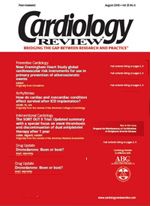Publication
Article
Rate control versus rhythm control in atrial fibrillation
Atrial fibrillation has been and remains the most common arrhythmia; however, optimal management strategies are still the subject of much discussion and
controversy. It has been assumed previously that rhythm control is preferable to rate control for a variety of reasons, including better relief of symptoms, lower risk of thromboembolic events, and lower incidence of congestive heart failure. In addition, there is a “cosmetic” advantage to maintaining sinus rhythm, at least for the practitioner. In the last few years, a
number of studies have compared a strategy of rate control and anticoagulation with one of rhythm control, the largest being the Atrial Fibrillation Follow-up Investigation of Rhythm Management (AFFIRM) trial.1-3 The findings of these studies challenge the belief that maintaining sinus rhythm is preferable in the majority of patients.
The study by Kaufman and colleagues (page 18) assessed the risk of proarrhythmic events in the rhythm control arm of the AFFIRM trial. Indeed, this is an important study, given the trend in this trial toward increased all-cause mortality, as well as the greater number of hospitalizations among patients taking antiarrhythmic drugs. The issue of proarrhythmia has been extensively studied; for example, the Cardiac Arrhythmia Suppression Trial demonstrated increased mortality with the use of class IC antiarrhythmic drugs in patients with ischemic heart disease.4 Other trials have shown increased mortality in patients with atrial fi-brillation who were treated with Class I antiarrhythmic drugs.5-7 It is important to note that although these drugs can be hazardous in certain subsets of patients with structural heart disease, they can be quite safe in others. Moreover, the method of administering these drugs was varied in these studies, and over the years, certain unofficial guidelines have emerged in an effort to avoid proarrhythmia and possible syncope or death.8,9
The incidence of arrhythmic events at 5 years was surprisingly low in this study (5%) and accounts for a small portion of the total mortality of the rhythm control arm (27%). The incidence of torsades de pointes was slightly higher in the rhythm-control arm; however, the incidence was lower than that previously reported and occurred late, largely owing to the development of hypokalemia, hypomagnesemia, bradycardia, or worsening renal function.
Discontinuation of a drug due to pulmonary events occurred in 7.3% of patients in the rhythm-control arm versus 1.7% in the rate- control arm (P < .001), and nearly two thirds of the patients had been exposed to amiodarone (Cordarone, Pacerone). Whether this was related in any way to mortality is not known. In a recently published analysis of cause-specific modes of death in the AFFIRM trial, it was found that there was no difference in death due to cardiac cause (9% in the rhythm-control arm versus 10% in the rate-control arm). A significantly higher proportion of deaths in the rhythm-control arm were due to noncardiac causes (P = .008) and were pulmonary and cancer-related deaths.10
As the authors of this study point out, the AFFIRM investigators imposed strict guidelines regarding the use of antiarrhythmic drugs. For example, Class IC drugs could only be used in patients with a normal left ventricle and a normal stress test. They were contraindicated in patients with congestive heart failure, structural heart disease, myocardial disease, left ventricular hypertrophy, coronary artery disease, abnormal left ventricular function or wall motion, or a left ventricular ejection fraction below 50%. On the other hand, while Food and Drug Administration guidelines (ie, in-hospital administration, assessment of renal function, etc) were followed for the use of dofetilide (Tikosyn), no such restrictions were placed on the use of sotalol (Betapace, Sorine) or Class IA drugs. Whether or not these drugs were administered in an outpatient setting is unknown; however, because this is not common practice, it can be assumed to be minimal.
The AFFIRM trial has challenged the notion that sinus rhythm is preferable to rate control in atrial fibrillation; however, it has raised a number of questions, and the answers are by no means simple. This analysis provides us with important information and insight that is crucial to our decision making regarding specific therapy for specific patients. In the AFFIRM trial, the trend toward increased mortality in the rhythm-control arm does not appear to be related to proarrhythmia. Nonetheless, proarrhythmia from antiarrhythmic drugs can be minimized by careful patient selection and strict adherence to dosing and monitoring requirements.
